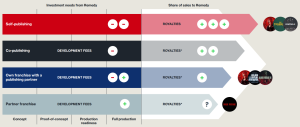Remedy’s possible business models include partner IP projects, own IP projects with a publishing partner, co-publishing projects and self-publishing.

In partner IP projects, Remedy’s partner funds the development of the game and Remedy develops it according to agreed specifications. Remedy receives development fees, typically with a margin, as the game development reaches the jointly agreed milestones. Remedy or the partner originates the game concept. In this model, the partner retains control of the intellectual property rights to the game and publishes, distributes, and markets the game. The project can include a royalty opportunity, typically after recouping development and marketing investments, for Remedy that is tied to the game’s success. Partner IP projects carry a lower financial risk for Remedy, but participation in the game’s success is also limited.
In own IP projects with a publishing partner, Remedy’s partner typically funds the game development, partially or in full. Remedy creates and retains the intellectual property rights of the game and is responsible for the development of the game. The partner publishes, distributes, and markets the game. As the game development progresses, Remedy receives development fees upon reaching the agreed milestones. Unlike in partner IP projects, these development fees are typically without margin, as they are intended to only cover Remedy’s development expenses to the level agreed with the publisher. Once the game is launched, these development expenses, the partner’s marketing costs, and other costs may be recouped against game sales. After the development, marketing, and other agreed costs are covered, Remedy starts receiving royalties from game sales. Own IP projects carry a higher financial risk but also a greater royalty potential for Remedy.
In co-publishing projects, Remedy and its partner co-fund the development of the game. Remedy carries the main responsibility for the development, while publishing, distributing, and marketing responsibilities are distributed between the two companies as per agreed terms. For Remedy, co-publishing projects carry a relatively high financial risk but also a greater royalty potential. In these projects Remedy is also more involved in the commercialization of the game. Typically, the royalty potential reflects the split in the project financing.
Self-publishing is a new publishing model for Remedy owned IPs. It has the highest financial risk but also the greatest revenue potential through game royalties. In self-publishing projects, Remedy fully funds the game development and marketing. As Remedy also acts as the game publisher, all royalties are directly realized as revenues after deducting sales related taxes and discounts. Platform fees, quality assurance, and localization are recognized as expenses.
Two commercial models for games
1. Premium fixed price games
Premium fixed-price games with a possibility of additional payable downloadable content is the model used in Remedy’s games up to Alan Wake 2. Historically Remedy’s games have been published and distributed by a publishing partner. Going forward, we will publish the games ourselves in which Remedy owns the IP.
2. Fixed-priced games with a service element
Fixed-priced games with a service element offer good longer-term revenue potential. These games can be premium to mid-priced titles with a longer revenue tail through potential game expansions and microtransactions. For these games, a key differentiator is the content created post-launch meant to keep players engaged for years. It can also attract new players to the game as they buy the base game giving access to the expanding amount of content to experience.